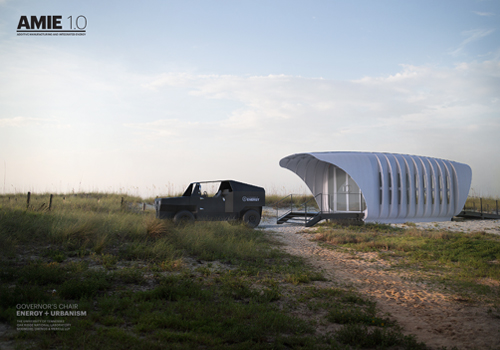September 23, 2015 AMIE 3D-Printed Structure Developed through Unique Collaboration, Student Input
Throughout the past decade, the University of Tennessee College of Architecture and Design has worked with Oak Ridge National Laboratory (ORNL) on several net-zero prototype buildings. In partnership with the ORNL Building Technologies Research and Integration Center (BTRIC), the college’s Institute for Smart Structures has focused its research on emerging materials and their impact on energy-efficient and energy-harvesting building envelopes. In this context, the Additive Manufacturing Integrated Energy (AMIE) can be seen as the most recent in a series of three full-scale prototypes that each build upon their predecessor’s innovations. AMIE also demonstrates design and innovation of College of Architecture and Design students and faculty, who worked collaboratively with UT-ORNL Governor’s Chair for Energy + Urbanism and Skidmore, Owings and Merrill (SOM) to develop AMIE.
Watch the archived video from the Oct. 21, 2015, panel discussion featuring experts from UT College of Architecture and Design; Skidmore, Owings and Merrill; Oak Ridge National Laboratory; and others.
Predecessors to AMIE
The first in the series was the UTZero prototype, a 300-square-foot net-zero building designed in collaboration with Dr. William Miller of the BTRIC and built entirely by students. This project set the precedent for the two future projects with its focus on photovoltaic power, use of shading devices, highly efficient but translucent enclosure, and exploration of floor-mounted LEDs to supplement daylighting.
Following the success of UTZero, the Institute for Smart Structures embarked upon the design and construction of the Living Light house for the 2011 Department of Energy (DOE) Solar Decathlon. In collaboration with eight programs on UT’s campus and working again with Dr. Miller, Living Light built on the technologies explored in UTZero. A significant feature of the house is the transparent double façade with its passive heating and integrated lighting. With its electric car charging station, the Living Light house was designed to be a net-zero compact housing and transportation solution for two occupants. In this regard, it foreshadows the AMIE prototype.
AMIE
The AMIE prototype embodies the mature form of many design features explored in the previous two projects: Its integrated solar array works in conjunction with a paired hybrid vehicle to provide all necessary power. Its form provides self-shading from direct gain while preserving light and view. AMIE’s unique interior packaging and color changing floor-mounted LEDs offer a new perspective on compact living spaces, and its structure, materials and efficient envelope point the way to ground-breaking new techniques in construction.
This envelope feature arose from a collaborative architecture studio course combining UT, Skidmore Owings and Merrill (SOM) and ORNL to explore the potential for incorporating large-scale additive manufacturing in building design. As the second in a series of research studios taught in partnership with the Governor’s Chair for Energy and Urbanism, a group of UT graduate architecture students explored the opportunities for form, space, light and structure afforded by 3D-printed polymer. With SOM architects present in the studio, the student research paralleled and influenced the design of the AMIE prototype. James Rose, Director of the Institute for Smart Structures, coordinated interaction between SOM, ORNL and the design studio and participated in design development discussions and construction observation visits to Clayton Homes and the ORNL Manufacturing Demonstration Facility.
The result is a powerful partnership between UT, SOM, and ORNL and the culmination of a decade of experimental net-zero prototypes by the Institute for Smart Structures.
Participating in the development of the AMIE prototype and previous projects affords UT students an unparalleled opportunity to work with the foremost professionals in design and engineering on projects of international significance. Exposing students to the collaborative environment and technological innovations of projects like these prepares them well for shaping the future of the built environment.
Learn more about AMIE and its unveiling in September 2015.



